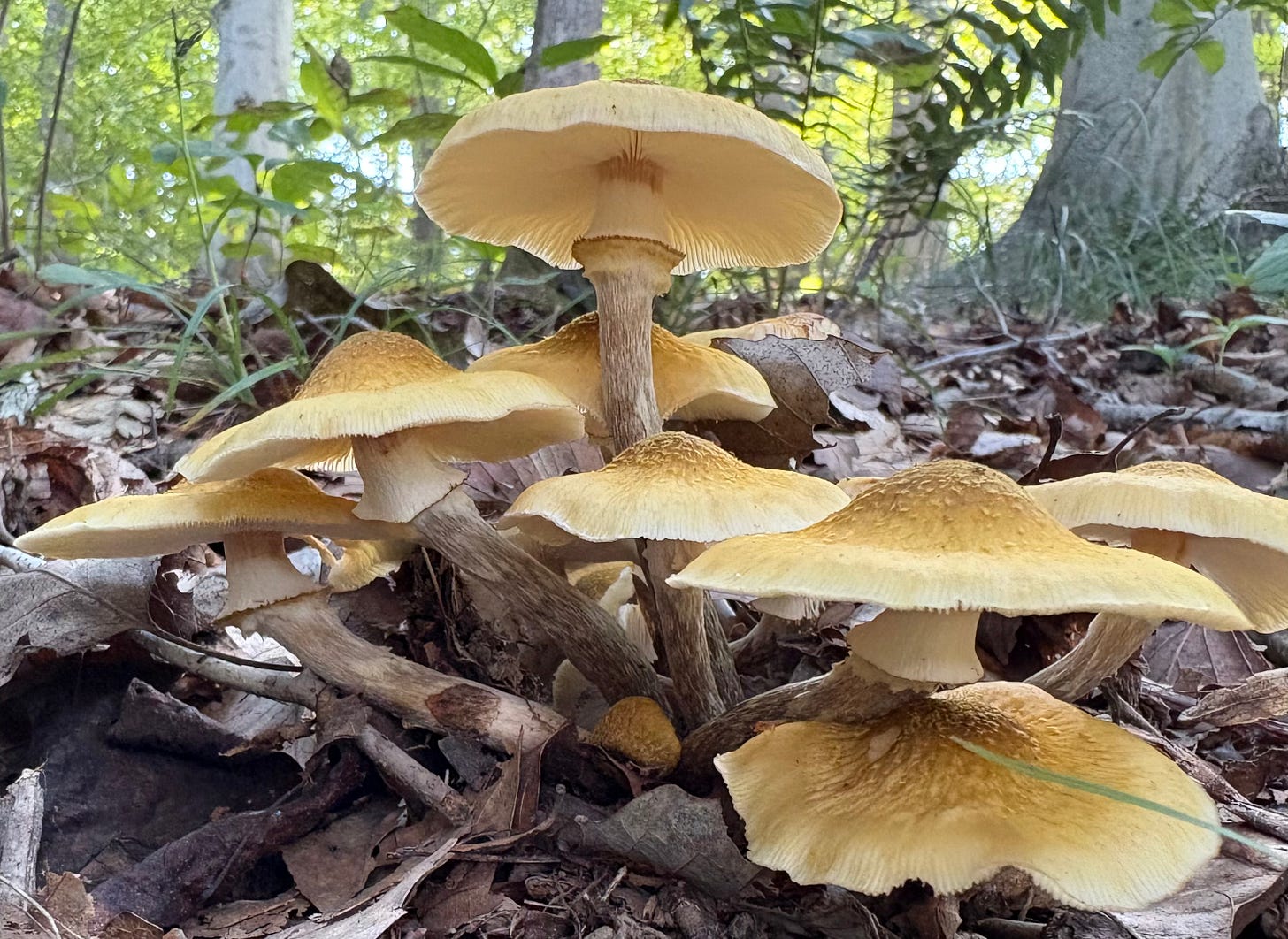Organic & Strategic Change in the Climate Movement, Part One
Olympian Fields of Action Series Post #9.1
As discussed in my previous post, the dynamic tension between the tried-and-true, discipline, freedom, and creativity gives rise to our next major characteristic/imperative/goal of the Climate Movement, being organic and strategic enough, which also creates a tension that we must use to propel us forward.
For us to be successful, we must have this tension be a creative one that sparks constructive new ideas and different approaches for achieving our vision, purpose, and Major Goal, which is the essence of being strategic.
It is the dynamic constructive dialogue between organic and strategic change that will help fuel our journey, making hope happen and our future come faster.
Ok, Sure, But What is Organic Change?
In earlier posts I have briefly characterized organic change rather vaguely as messy and nonlinear, noting that in nature plants don’t grow in straight lines as they seek the light.
Organic change in our Movement comes from the Climate Action Athletes who make us up. Organic change is endemic because of who we are as individuals, our personalities, our gifts, our passions, our values. Organic change doesn’t stifle or suppress these qualities, forcing us into a standardized mold; it sets us free.
When a group of individuals come together at a specific time and place to focus together on our vision, purpose, and Major Goal, it is something that has never happened before. What flows out of such experiences cannot be planned for; rather, it must be given the opportunity to come forth.
One of the main ways organic change arises is when a group of Climate Action Athletes come together and begin to interact and get to know one another and begin to do climate action together, whether in a Team or some other social form. Individual members can have climate action ideas that they bring to the group, whether those ideas occur to the individual when they are alone or when they are interacting with colleagues. If the group likes the idea, they mold it as needed and create how they will implement it.
Say, for example, that someone writes a poem and brings it to the group. Another member sets it to music. A third records them singing it and the group’s reactions and creates a video. A fourth is a wiz at Social Media with large followings and shares it.
This isn’t something that came out of a strategic planning process. Poetry doesn’t come off of a strategic planning assembly line: “In 2025 produce 5 poems on lament and 7.5 on joy each week. Increase this by 2.7 each subsequent year, while also increasing the experience of joy by 6.2% each year.”
It is the new combination of individual personalities, gifts, passions and values working as a team that drives organic change, creating a new human ecosystem where each individual finds their niche.
Just as every place in nature at every moment in time is a unique combination, so too does place and time and the individuals who inhabit them create relationships and opportunities that will never happen again, as the new continuously replaces the old.
Organic change flows out of kairotic time, which is always rooted in specific places and the people present in those places and the freedom they have to seize the moment and find a way to work together to give birth to something that hadn’t existed before.
As such, organic change is rooted in people, place, and time — the combination of which must be activated by freedom and fulfilled through creativity, two of our Movement Values.
With this rootedness in people, place, and time comes another factor driving the creation of organic change — the unique challenges of our time.
When such challenges overcome and overwhelm the tried-and-true approaches of the past we must become creative — if in freedom we are allowed to do so and allow ourselves to be so. And some of the most fertile ground for meeting new challenges and transforming the failures of the tried-and-true into victories comes from organic change.
Then Who Needs Strategic Change?
Some of you might be thinking, “Organic change sounds so great! Why do we need to restrain it in the straight-jacket of strategic change? Let freedom and creativity rule!”
Well, because organic change without strategic change can be self-indulgent, a form of creative narcissism. Worse from the Climate Movement perspective, it will be ineffectual and a waste of time and resources. Given the climate-clock — that every moment of every day we are in kairos-climate-time — ineffectual, self-indulgent organic change is something we can’t afford.
Organic change needs strategic change because as a Movement we are trying to achieve a certain outcome, we are trying to overcome a dire threat, we are trying to create a better world. In other words, we are goal oriented. And once you have a goal where time is of the essence, you must design a strategy to achieve it — unless you want to be a dilettante and a poser.
At the same time, strategic change without organic change will be stifling, limiting, and ultimately depressing for many. We will not achieve our vision, purpose, and Major Goal — the essence, the telos, of strategic change — without organic change. Why? Once again, because we’re on the climate-clock and the speed and scale of change needed has never been attempted in the history of humanity.
The need for speed and scale creates kairotic time, and requires organic and strategic change to work together like never before, treating every moment for what it is, an opportunity that will never come again, but offering a plethora of opportunities thereafter until they have all come and gone.
There’s no tried-and-true for some of the things we must do.
We need the creativity of organic change when the tried-and-true won’t get the job done, and because the challenge itself requires solutions that weren’t needed in the past. There’s no tried-and-true for some of the things we must do. We need the freedom to express the gifts of all of our Climate Action Athletes. We simply can’t afford to leave such resources on the table. We can’t afford to have anyone feel despondent because their gifts and ideas are being ignored or even belittled.
Just as in American football, where a “broken play” can result in a big gain or a touchdown, creative improvisation as the need arises can result in major gains for the Climate Movement.
But “broken plays” take place in the context of rules and game plans and a clock. Any team that only relied on broken plays will get beat every time by a well-coached team that has a game plan.
Another example is, of course, creative improvisation in music. Bach, Handel, Mozart, Beethoven, and Chopin were incredible improvisers.
For one musical form in particular, Jazz, creative improvisation is not simply an occasional feature; it is at its very center, such as can be found in the musical genius of Louis Armstrong and all those that followed in his footsteps.
But such improvisation takes place in a musical structure using instruments that have to be played a certain way to make notes in tune; the same goes with a human voice singing Jazz. (Even so-called “free jazz” had its own ideas that determined how improvisation was to happen.)
Within these structures there can be tremendous freedom, but freedom with purpose. Jazz has a purpose, to create art, and this purpose has goals, such as personal and ensemble satisfaction and audience appreciation. A symbiosis of Organic-&-Strategic.
We Are Climate Action Artist-Athletes
Organic change within the Climate Movement invites us to see ourselves and our teammates as artists — but artists with a purpose: to overcome climate change by creating a just and prosperous sustainability that enhances wellbeing for everyone and everything. We exist to be Artist-Athletes who make the impossible possible and the possible actual and the actual beautiful and our future come faster. Only Organic-&-Strategic-Change working together will make this a reality, a reality filled with hope. Join us!
If you are new here, check out our Intro Series, and the other posts in this Olympian Fields of Action Series about the Climate Movement. If you like this post, please “like,” comment and share. And thanks for all you’re doing.









